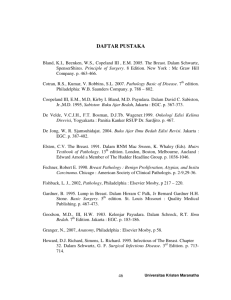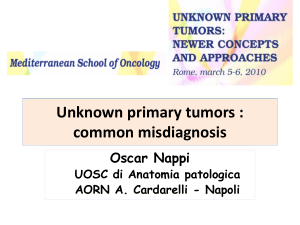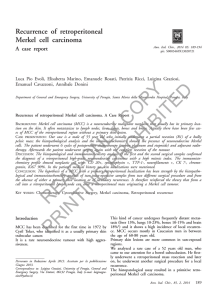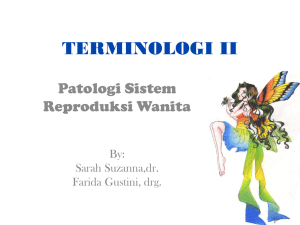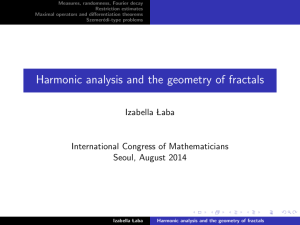Mucinous carcinoma of the breast with neuroendocrine
advertisement
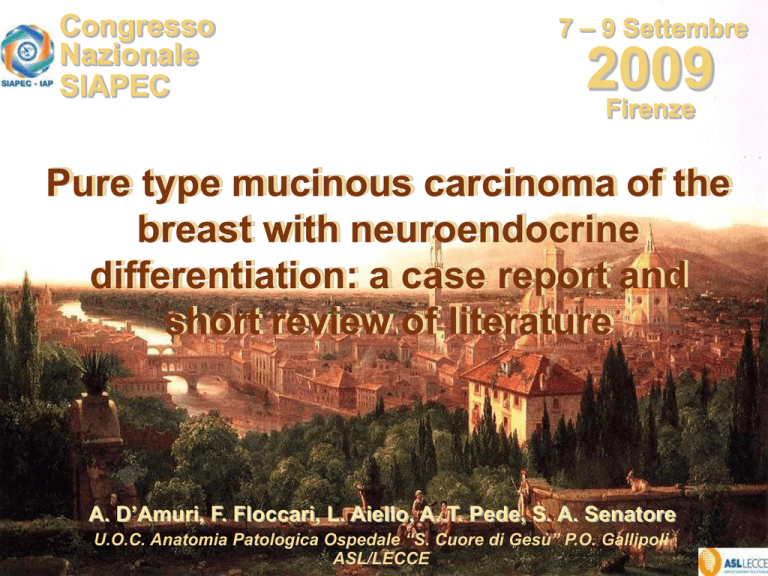
Congresso Nazionale SIAPEC 7 – 9 Settembre 2009 Firenze Pure type mucinous carcinoma of the breast with neuroendocrine differentiation: a case report and short review of literature A. D’Amuri, F. Floccari, L. Aiello, A. T. Pede, S. A. Senatore U.O.C. Anatomia Patologica Ospedale “S. Cuore di Gesù” P.O. Gallipoli ASL/LECCE INTRODUCTION Mucinous carcinoma (MC) is a special type of invasive breast neoplasm grouped into pure and mixed types: the former contains only tumour with the typical mucinous carcinoma morphology; the latter is mixed with conventional infiltrating ductal carcinoma. Some authors subdivided MC components on the basis of mucin content, epithelial growth pattern and associated figures in type A (tumors containing 60-90% of mucin) and type B (tumors containing 33-75% of mucin). A large proportion of MC show a neuroendocrine differentiation and its significance is still unclear. INTRODUCTION MC with or without neuroendocrine differentiation occurs in the elderly and the proportion of postmenopausal patients is high. The symptom and sign is palpable mass and bloody nipple discharge. The evaluation of MC outcome is difficult because of the short follow-up period due to the old age of the patients who may die of other unrelated causes. The majority of patients do not show local recurrences or distant metastasis. Lymph nodes metastasis are rare. CASE REPORT An 82 year old woman with no significant medical history showed a palpable mass in her retro-areolar right breast. The patient underwent radical mastectomy and right axillary lymph nodes dissection. SURGICAL FEATURES Grossly the right breast showed nipple retraction, discromic skin with a normal areolar gland. The remaining breast parenchima had a lipomatous aspect. In the retro-areolar region a 4x4x2cm nodular lesion was observed. The nodule had a hard-elastic consistency, a yellowish white appearance with interspersed brownish and gelatinous areas. MATERIALS & METHODS Once removed specimens were fixed in 10% buffered formalin and paraffin embedded. 5mm serial sections were obtained and routinely stained with haematoxylin-eosin (H/E) and histochemically evaluated with Grimelius. Immunohistochemical studies were performed for Neuron Specific Enolase (NSE), Chromogranin (CGA), Synaptophysin (SYN), Neurofilament (NF), estrogen (ER) and progesteron (PgR) receptors, c-erbB-2 and Ki-67 (MIB-1). MICROSCOPICAL FINDINGS Microscopically we observed small clusters of tumor cells with abundant extracellular mucin accumulation (65%). The cells were small to medium sized with a spindle shape. The nuclei appeared uniform and the cytoplasm eosinophilic and finely granular. The 19 axillary lymph nodes were found all negative for metastasis. MICROSCOPICAL FINDINGS Immunohistochemical stains for NSE, CGA, SYN and NF were positive with a marked histochemical expression of Grimelius (argyrophilic cells). The tumor was positive for estrogen (90%) and progesteron (80%) receptors, incompletely positive for c-erbB-2 (15%) with a low Ki-67 proliferative index (10%). A diagnosis of pure type mucinous carcinoma (hypercellular variant) of the breast with neuroendocrine differentiation was performed. H&E H&E Grimelius NSE SYN CGA Estrogen receptors Progesteron receptors DISCUSSION MC of the breast is a good prognostic type malignancy which may occur in elderly patients. MC is most commonly associated with neuroendocrine differentiation. Neuroendocrine differentiation has long been described but its significance is still unknown. The criteria for diagnosing neuroendocrine differentiation is based on immunohistochemistry, histochemistry with Grimelius for argyrophil reaction and electron microscopy evaluation. DISCUSSION As reported in literature some authors consider the expression of the neuroendocrine markers namely CGA, SYN and NSE definitive. Other authors used two out of three positivity as diagnostic criteria. It is also associated with higher expression of estrogen and progesteron receptors and lower c-erbB-2 oncoprotein expression and with a low Ki-67 proliferative index. Lymph nodes metastasis are uncommon. DISCUSSION In our case report the clinicopathological features were similar to those reported in literature and included the presence of clusters of tumor cells of moderate-grade with abundant extracellular mucin accumulation. Our histochemical study (positive for Grimelius) and immunohistochemical findings (positive for CGA, SYN, NSE, NF; higher expression of ER and PgR receptors and lower expression of Ki-67 and c-erbB-2) strongly support the diagnosis. This type of tumour occurred in an old patient and the axillary lymph nodes were found all negative for metastasis as reported in previous studies. REFERENCES Kato N. et al. Mucinous carcinoma of the breast: A multifaceted study with special reference to histogenesis and neuroendocrine differentiation. Pathol Int 1999; 49: 947-955 Nakagawa H. et al. Mucinous carcinoma of the breast with neuroendocrine differentiation. Pathol Int 2000; 50: 644-648 David O. et al. Diffuse neuroendocrine differentiation in a morphologically composite mammary infiltrating ductal carcinoma. A case report and review of the literature. Arch Pathol Lab Med 2003; 127: e131-e134 Tse GMK. et al. Neuroendocrine differentiation in pure type mammary mucinous carcinoma is associated with favorable histologic and immunohistochemical parameters. Mod Pathol 2004; 17: 568-572

